We eventually agreed on a quid pro quo: I would go to see Poison and Cheap Trick if she would go to see Deep Purple and Judas Priest, slated to play in Irvine later this year on September 27. Considering that both shows had a straight-up $20 charge with no fees and, as we discovered, the concert venue did not charge for parking, this was a fair price for a night out and some live commercial rock and roll.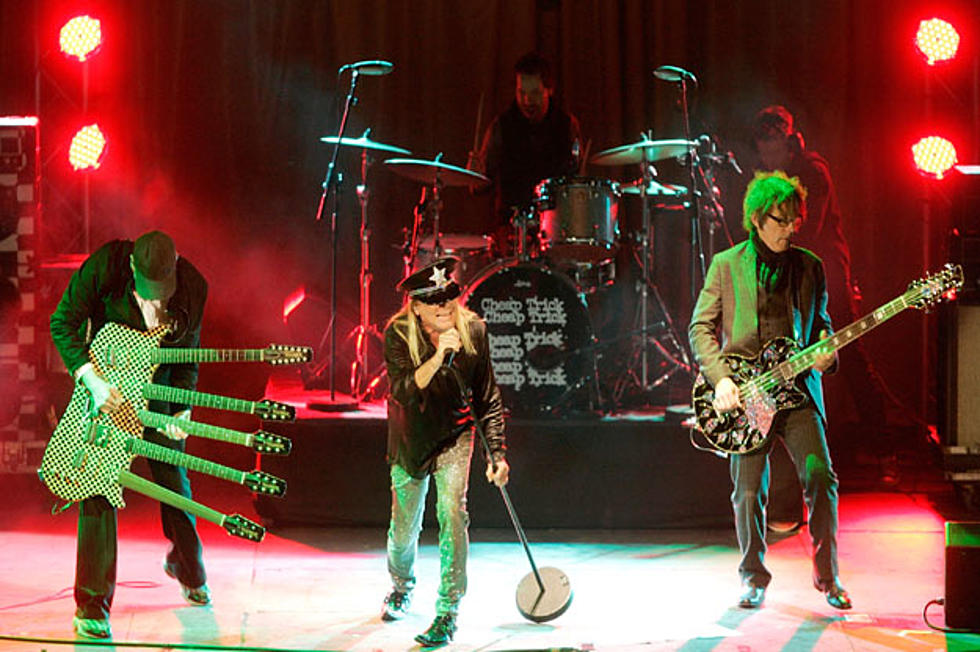
Inducted into the Rock and Roll Hall of Fame in 2016, Cheap Trick proved that it was still a top-tier hard-rock band not about to "Surrender."
The Venue: FivePoint Amphitheater
Opened in 2017, FivePoint Amphitheater in Irvine is the successor to Irvine Meadows Amphitheater, once also known as Verizon Wireless Amphitheater, but under any name closed for business in 2016 to make way for apartment complexes, thus depriving residents of south Orange County of a large-scale concert venue that had been in operation since 1981 and had hosted a broad range of musical tastes from the Pacific Symphony Orchestra to Michael Jackson, Miley Cyrus, and Adele to the Grateful Dead, Prince, and the Smiths. Nestled on the slope of a coastal foothill, Irvine Meadows was a pleasant outdoor locale where even the cheap seats, including the grassy terrace at the top of the seating area, kept you in the concert, particularly since the advent of video screens adorning the stage.
By contrast, FivePoint is a work in progress, although considering the development saga surrounding it, it is progress. This outdoor amphitheater is built on the remains of the El Toro Marine Base (officially Marine Corps Air Station El Toro), which dates back to World War Two and which sported four runways, including two that were nearly two miles in length and could accommodate any airplane up to the behemoth Lockheed C-5 Galaxy transport jet. That made El Toro a crucial domestic airbase throughout the Cold War. President Richard Nixon landed at and departed from El Toro in Air Force One whenever he visited his "Western White House" private residence in nearby San Clemente, and Lee Harvey Oswald, alleged assassin of John F. Kennedy, had been stationed at El Toro twice during his stint in the Marines in the late 1950s.
When it was announced in 1993 that El Toro would close by 1999, heated and protracted debate erupted over what to do with these more than eleven square miles of land—and in Southern California, land such as this is at a juicy premium.
One initiative was to re-purpose the existing facilities into a new international airport. Not a bad idea, as John Wayne Airport, which services Orange County, is a bandbox with a single runway just over one mile in length that is unable to accommodate any wide-body airliner, and as John Wayne is located smack-dab in the middle of urban Orange County, any expansion is practically impossible. (Kathie and I work in an office building minutes away from John Wayne, from which we can see airplanes making their final approach in between the office buildings.) As Orange County, no longer simply a collection of sleepy bedroom communities for Los Angeles to the northwest, has grown into a commercial hub, so too should its airport, which is minutes away from branch offices of Oracle, Microsoft, Google, J.P. Morgan, Ernst & Young, and many others, grow commensurately.
But for residents surrounding El Toro Marine Base, the idea of a commercial airport was anathema—in the 1980s, as the stretches of orange groves that gave the county its name were leveled to create many of those bedroom communities, newly-settled residents complained about the noise from El Toro, a complaint that only grew louder as this burgeoning population grew. So, naturally, these communities were opposed to a new airport, and a spirited wave of ballot measures and court challenges enlivened local politics until the airport initiative was quashed. In its place came the Orange County Great Park, approved by Orange County voters as Measure W in 2002, which would occupy a little more than one-quarter of the land that formerly housed the airbase, with that large remainder re-zoned for commercial and residential development.
What has any of this got to do with a rock and roll concert? Rock and roll is a business, folks, and in an era in which recordings do not generate as much revenue as do concert tours, where rock artists can play has importance, particularly for an Eighties hair-metal band such as Poison and a Seventies glam-rock band such as Cheap Trick, both of which rely on the nostalgia crowd for customers. And for members of those crowds who live in south Orange County, having a local large-scale venue to replace the late, lamented Irvine Meadows is a blessing, which is where Great Park, home to FivePoint, enters the picture.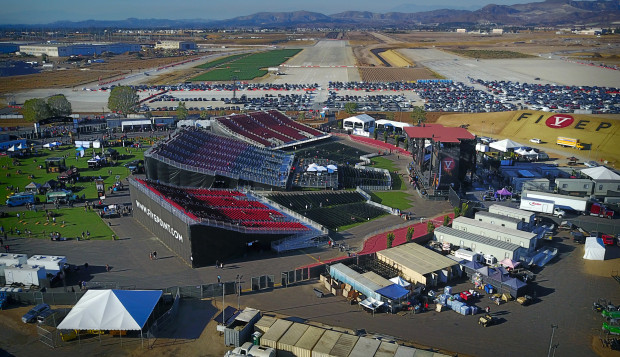
Built on the remains of a Marine Corps airbase, Irvine's FivePoint Amphitheater currently resembles a traveling carnival set-up.
That said, FivePoint, as noted previously, is a work in progress. Located in a lonely corner of the old airbase, it hardly has the look of permanence: The "amphitheater" is no more than three banks of steel bleachers arrayed in a semi-circle before a serviceable stage. Leading up to the bleachers is an encampment of concessionaire kiosks offering refreshments and souvenirs, with stands of portable restrooms nearby. A cross between a single-wide trailer and an airplane toilet, these restrooms are an improvement over the venerable Porta-Potty. But before our parents and grandparents begin to admonish us with their tales of Woodstock, of sleeping in the mud and rain with a half-million other Age of Aquarius pioneers, yet having the time of their lives, I am reminded that the concert experience has now become like the title of an old Dead Kennedys comp: Give Me Convenience or Give Me Death.
Presumably, after having been rushed into service after Irvine Meadows closed, FivePoint will grow into a permanent facility and not remain like the traveling carnival that sets up in the parking lot of your local shopping center, hawking dubious-looking hot dogs and cotton candy and sketchy rides on the Tilt-A-Whirl to help you bring up said junk food, then packs up for another town a couple of weeks later, leaving in its wake rampant indigestion and at least a couple of teen pregnancies. For now, FivePoint is a nearby venue for mid-level concerts, including one that featured a band recently inducted into the Rock and Roll Hall of Fame.
Cheap Trick: No "Surrender" After All These Years
Alongside Kiss in the 1970s, Cheap Trick enlivened the hard-rock scene with a tongue-firmly-in-cheek approach that showed the band quite willing and able to have serious fun. But Cheap Trick was, lyrically and musically, a much better band than Kiss, which had to rely upon Kabuki makeup and theatrics to distinguish itself from the hordes of garden-variety hard-rock acts.
Arguably, though, it was the saga of Kiss and the Rock and Roll Hall of Fame—amidst vehement resistance within the Nominating Committee, Kiss finally got onto a Rock Hall ballot in 2010 and was elected on its second try in 2014—that paved the way for Cheap Trick, eligible since 2003, to be elected to the Rock and Roll Hall of Fame on its ballot debut in 2016.
Still, along with its hard-rock chops, Cheap Trick also had a distinctive look; in rock critic Dave Marsh's deathless description, Cheap Trick was "the least likely looking combo of the day: vocalist Robin Zander and bassist Tom Petersson were rock-star slim and blown-dry, but guitarist/songwriter Rick Neilsen was a ringer for Huntz Hall of the Bowery Boys and drummer Bun E. Carlos looked like an overweight war criminal on the lam."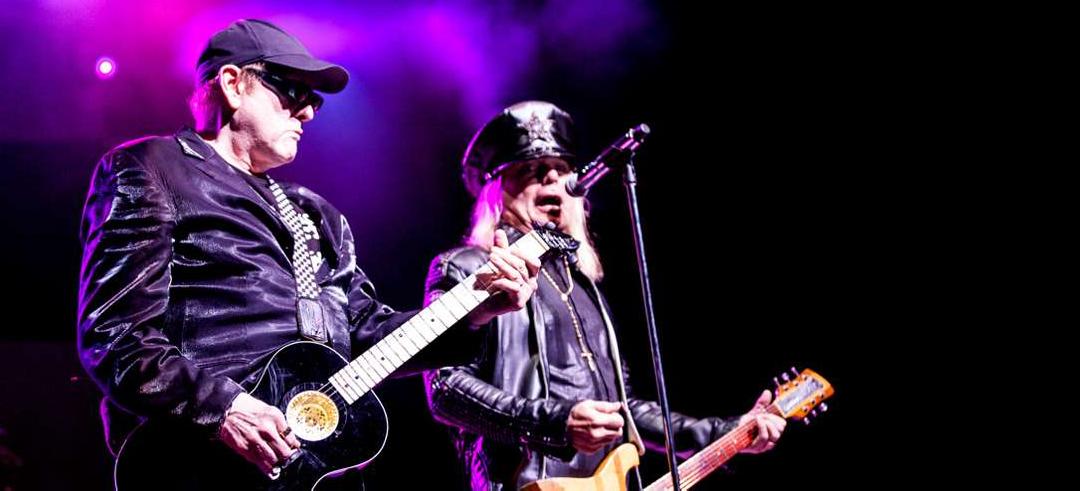
The front half of Cheap Trick: Lead guitarist Rick Neilsen (left) and singer-guitarist Robin Zander give the band its distinctive voices.
Even at age 69, Neilsen still looks like Hall, but Carlos no longer performs with the band, although Cheap Trick has kept the percussion work in-house. Taking Carlos's place on the drum riser is Neilsen's son Daxx, and if Rick Neilsen has been follicly-challenged throughout the years—thus explaining his ubiquitous billed cap—the younger Neilsen got his father's allotment of hair—his curly locks billow from either side of his head like Bozo the Clown's.
However, there is nothing clownish about Daxx's drumming, which faithfully re-creates Carlos's strong, solid beat, especially during the extended tom-tom thumping that opens "Ain't That a Shame." (Zander has also kept it in the family: His son Robin, Jr., lurked discreetly at stage left playing rhythm guitar.) Musical talent certainly runs in the Neilsen family: Rick's parents were both opera singers who owned a music store in Rockford, Illinois, and Rick himself was a drummer before he switched to guitar. Weaved into Cheap Trick's "ridiculous arabesques" (Marsh's description) is Neilsen's "astonishing guitar work" (Marsh again), and throughout Cheap Trick's set he didn't lose a step on those thunderous riffs and squalling leads and fills.
Neilsen is also, famously, a connoisseur collector of guitars, with an estimated 500 in his current stash, fifty of which he brought along on this current Nothing But a Good Time tour—and several of which got prominent display during the hour-long set as he changed guitars after every song, saving his trademark five-necked Hamer for the finale.
In the 1970s, Cheap Trick roared out of the gate with the albums Cheap Trick (Epic, 1976) and especially In Color (Epic, 1977) and Heaven Tonight (Epic, 1978), all of which featured songs that could be a little bit dark ("Auf Wiedersehen," "Heaven Tonight"), a little bit absurd ("He's a Whore," "Big Eyes"), and quite a bit inscrutable yet still oddly engaging. But Dream Police (Epic, 1979) fumbled for the Big Statement despite the success of the title track and the extended stomper "Gonna Raise Hell," and the band stumbled throughout the 1980s—although you might have forgotten about its ballsy "Reach Out," one of the highlights of the 1981 Heavy Metal film soundtrack—until 1988's Lap of Luxury (Epic) yielded the chart-topping power ballad "The Flame," which showed that the band had been picking up cues from Heart, Foreigner, and other Seventies refugees scrambling for relevance a decade later.
Another glossy ballad, "Can't Stop Fallin' into Love," from 1990's Busted (Epic), continued the slide into adult contemporary, and an attempt to arrest that slide following the band's departure from Epic, Woke up with a Monster (Warner Bros., 1994), featured a groaning title song that descended into self-parody, leaving "Can't Stop" as Cheap Trick's last entry in the Top 40 and relegating the band to nostalgia status, putting out product largely for the fanbase.
Cheap Trick's signature album may be 1979's Live at Budokan (Epic), the greatest live album recorded in Japan by a Western classic-rock hard-rock band not named Deep Purple, and one that still serves as the model for Cheap Trick's live sets, as demonstrated by the band's show at FivePoint.
The band indeed opened with "Hello There" and closed the set with "Goodnight Now," songs that framed Live at Budokan; they were two of the thirteen songs that drew overwhelmingly from Cheap Trick's glory period, although the band's latest released album (it is still working on an upcoming album), We're All Alright! (Big Machine, 2017), yielded "You Got It Going On" and "Long Time Coming," which Rick introduced as the band's latest single that has "spent 37 weeks at Number One . . . somewhere in South America." (Actually, Cheap Trick had released a new single, "The Summer Looks Good on You," just hours before it took the stage. And although it might not be "South America," "Long Time Coming" did spend "an unprecedented run of 18 weeks at #1 on the Mediabase Classic Rock chart.")
Both songs, particularly the latter, sounded like an encouraging return to form, but this was a crowd that expected to hear the classics. Did the band let them down? Hell, no—Cheap Trick delivered them in black-and-white checkerboarded spades.
After the coy greeting of "Hello There" came "Big Eyes," one of Neilsen's catchy but inscrutable efforts that still leaves me wondering why "Big Eyes" is such a "losing cause." Further down the line came "Baby Loves to Rock," from 1980's All Shook Up (Epic), which the band had recorded with producer George Martin. Sir George was of course effectively "the fifth Beatle" as he produced the Fab Four—and Cheap Trick's hooking up with him only underscored the Beatles' influence on the band, which often features Neilsen and Petersson executing note-perfect Beatle-esque harmonies behind Zander. (The body of one of Neilsen's guitars sported a Sgt. Pepper's-era photo of the Fab Four).
"Baby Loves to Rock" qualified as the rarity in the set—it's not the best-known song from All Shook Up—but before that came a pair of songs that are indeed very well-known to even casual Cheap Trick fans. Following "Big Eyes," the band kept the momentum going with the rowdy "California Man," geographically appropriate as this inaugural concert took place in California—and we'll get to the constant reminders that we were indeed in the Golden State soon enough—before Daxx began pounding the skins for another vintage rip through "Ain't That a Shame," a high point on the Budokan album and certainly one here.
Both songs, aside from long being concert staples for the band, emphasize Cheap Trick's homage to the rock and roll continuum. Our Woodstock forebears know that "Ain't That a Shame" was first a signature tune for one of rock's Founding Fathers, Antoine Domino, although we know him better as Fats. And it's not surprising that the founding members of Cheap Trick, having grown up listening to the foundational rock epitomized by the Rock and Roll Hall of Fame's inaugural Class of 1986, of which Fats Domino is indeed a member, would cotton to a cover of "Ain't That a Shame."
But Cheap Trick has a deeper understanding of rock and roll. "California Man" was not written by Neilsen or any other band member—it was penned by Roy Wood, a founding member of the Move, an English band that would disintegrate not too long after it released "California Man" as a single in 1972. In the United Kingdom, the Move rivaled only the Who and Small Faces as a Sixties Mod band, but it made almost no inroads in the US save for the perspicacious members of Cheap Trick.
Ironically, the Move's "California Man" even got eclipsed as a single—"Do Ya," one of the songs on the flip-side, proved more popular as it became the only Move song to chart on the US Billboard Hot 100, scraping to 93rd place. "Do Ya" was written by Jeff Lynne, who had joined the Move in its waning stages and later formed the Electric Light Orchestra from the ruins of the Move; ELO's version of "Do Ya" made it to Number 24 on the US Hot 100 in 1977, paving the way for ELO's eventual induction into the Rock and Roll Hall of Fame thirty years later.
Back at FivePoint, Cheap Trick continued to connect the rock and roll dots for fans. Following the extended solo by Petersson on his 12-string bass that came after "You Got It Going On," the band launched into an earnest cover of "I'm Waiting for the Man," the Velvet Underground's quintessential ode to scoring drugs, specifically, heroin, which, consciously or not, becomes a social statement of sorts given the current opioid epidemic in the US. (Speaking of drugs, as Californians voted to legalize marijuana in 2016, a law that did not become effective until this year, that sickly-sweet smell of sinsemilla seemed more prevalent than at recent concerts.) Petersson did the vocal honors for "I'm Waiting for the Man," and his gruff croak was certainly no worse than Lou Reed's gravelly vocal fifty years ago.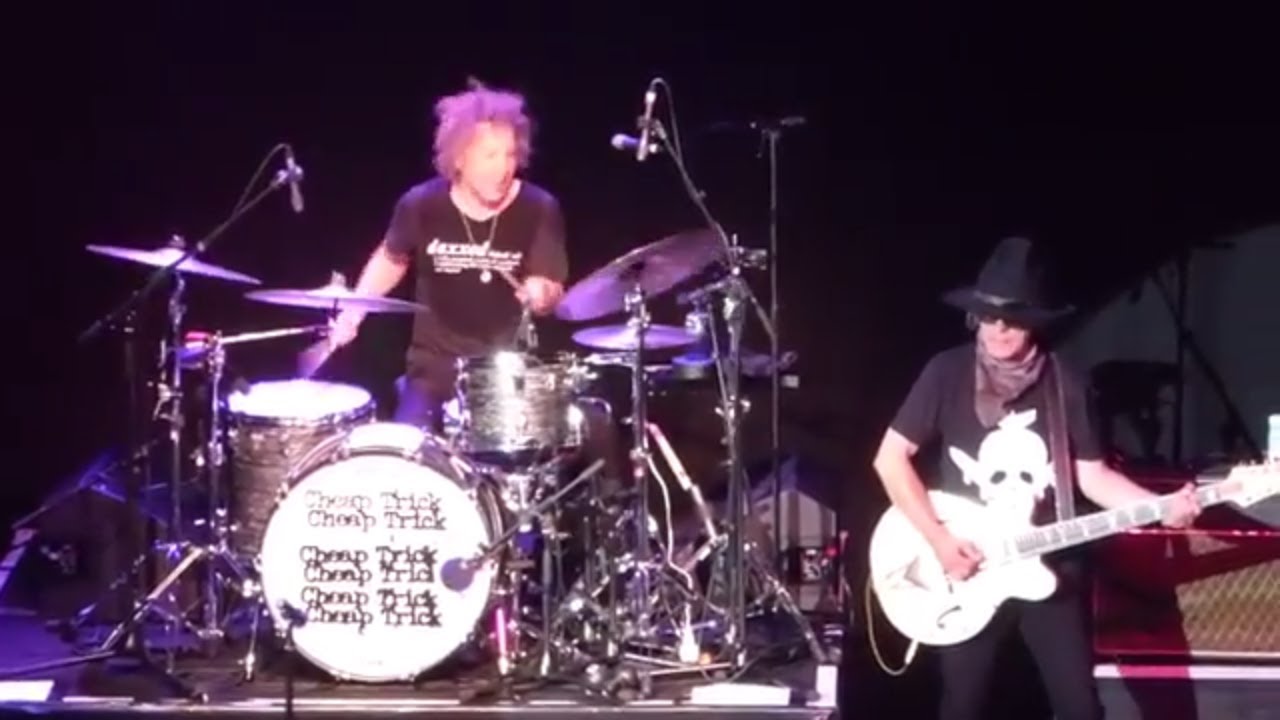
The back half of Cheap Trick: Neilsen's son Daxx now pounds the skins, but bassist Tom Petersson is still thundering after all these years.
As is true for many bands including Cheap Trick, some obligatory songs must be exactly that—obligatory. Zander strapped on the acoustic guitar for "The Flame," which hinted that time does catch up with all of us, and that included his voice on the only "mellow" one in the set. And though it was better suited for how he sounds now, Zander seemed blasé in his reading of "I Want You to Want Me," the band's only other Top Ten single, reaching the seventh spot in its live incarnation from Budokan back in 1979.
Yet Zander sounded reinvigorated as he belted out a rousing rendition of "Dream Police," which also lit a fire under the band—and that could only mean one thing: "Surrender." Originally included on Heaven Tonight, this inspired rocker, indisputably a classic-rock anthem, is one of the wackiest expressions of the rock and roll sensibility—or is that insensibility?—and it was the one song that got me up on my feet, dancing like a fool and singing like an idiot at the top of my lungs every blessed word. As Dave Marsh, writing in The New Rolling Stone Record Guide (1983), put it so memorably: "'Surrender' . . . is a gem: Neilsen's parents wig out behind their own advice to him and make out on the couch while listening to Kiss records. If that isn't your idea of surrender, you've wandered into the wrong book by mistake." Or, on this night, the wrong concert.
And, after "Goodnight Now," that was it. One hour of classic classic rock from Cheap Trick, a recent inductee into the Rock and Roll Hall of Fame but one that, even after 5000 concerts over its career, still felt the flame to perform. At least in Irvine this night.
Opening for Cheap Trick was Pop Evil, the Michigan-based alternative metal quintet fronted by Leigh Kakaly that released its first album, Lipstick on the Mirror (Universal Republic), in 2008 and is touring to support its latest album, Pop Evil (eOne Music, 2018). With a crunchy sound and a strong single in "Waking Lions," the band displayed influences from Alice in Chains and Rage Against the Machine, among others, although out-of-stater Kakaly made sure to give regular shout-outs to "California," which Poison's Bret Michaels seized upon eagerly . . .
Poison: Look What the Cat Dragged into FivePoint
Even though Poison has not released any new material in more than a decade, this hair-metal stalwart headlines the Nothing but a Good Time tour, slated to end June 24.
But to tell from the crowd—middle-aged men valiantly trying to disguise their paunches (or not) while the women squeezed themselves into Spandex, push-up bras, and stiletto-heeled boots—they were aglow with memories of roaming Sunset Strip in the 1980s, the heyday of Hollywood glam-metal, with Van Halen having blazed the trail and Guns 'N Roses just around the corner. And with an opening cartoon that paid tribute to that bygone era, Poison proved that it knew its demographic to a tee—even one that looked worn-out from too many washings.
Fittingly, then, Poison drew its dozen-song set exclusively from its first three albums, all released on Enigma/Capitol: Look What the Cat Dragged In (1986), Open Up and Say . . . Ahh! (1988), and Flesh & Blood (1990), and all near-chart-toppers from that halcyon period. (The debut peaked at Number Three on the Billboard Top 200 albums chart while the next two each reached Number Two.) There were no surprises and, for fans, no disappointments—that signature Poison song arrived sooner or later. But as this was generic and derivative glam-metal when it was first released, you had to wonder if the audience was there for the band—or simply for themselves.
Give Poison this much: The band went through its dues-paying days. Trekking from Pennsylvania to Los Angeles in 1983, it joined countless bands hoping to become the next Ratt, Mötley Crüe, or even Van Halen, eventually landing gigs at the Troubadour to build a local following. When original guitarist Matt Smith returned to Pennsylvania in 1985, singer Bret Michaels, bassist Bobby Dall, and drummer Rikki Rockett recruited C.C. DeVille to replace him.
By 1986, Poison had signed with Enigma Records and released Look What the Cat Dragged In, whose initial single, "Cry Tough," failed to chart—but the next three singles from the record did make the Billboard Hot 100: The raunchy rocker "Talk Dirty to Me" peaked at Number Nine while the heartbreak ballad "I Won't Forget You" went to Number 13 and "I Want Action," another unsubtle me-want-sex-now rocker, got as far as 50th place. Then, with a cover of Kiss's "Rock 'n' Roll All Nite," the band landed on the 1987 Less Than Zero film soundtrack alongside Aerosmith (a cover of "Rockin' Pneumonia and the Boogie Woogie Flu"), the Bangles ("Hazy Shade of Winter"), LL Cool J ("Goin' Back to Cali"), and Slayer (a cover of "In-a-Gadda-Da-Vida"). Poison had arrived.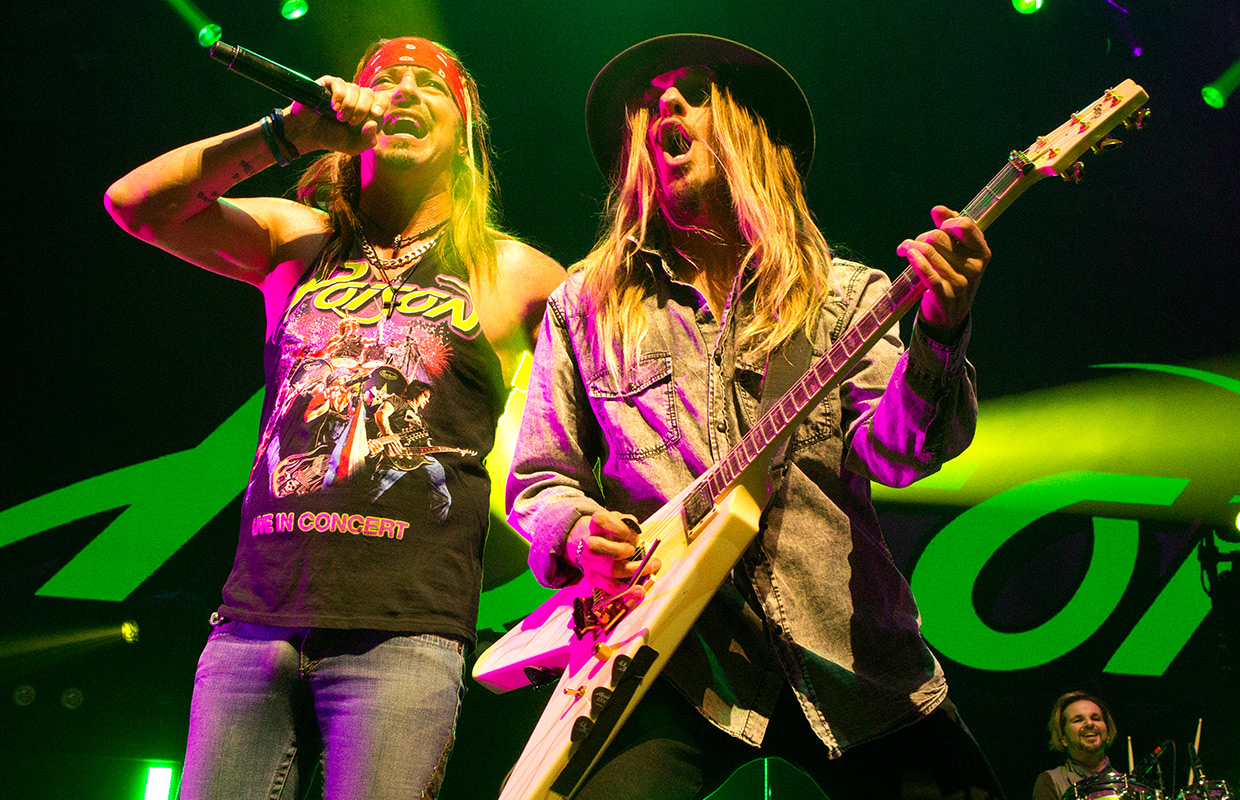
Mugging with guitarist C.C. DeVille, singer Bret Michaels praised "California" to the skies in his efforts to fire up this Golden State crowd.
Poison opened with "Look What the Cat Dragged In" before diving immediately into "I Want Action" to get the crowd fired up. Then Michaels really began to talk. Again, give Poison this much: The band appreciates its fanbase, almost to the point of solicitousness. That might not be too surprising—Poison is beginning its sixth tour without a new album to promote, so it might well be grateful that the faithful keep returning. By the mid-point of the set, I figured that my name had become simply "California" since Michaels made sure to address the crowd as such every second sentence.
Part of Michaels's rap was the allure of roaring down the open road on his motorcycle. Cue "Ride the Wind," the first of three tracks from Flesh & Blood, as black-and-white footage of biker gangs flickered on the video monitor above the drum riser (although a lack of images from The Wild One seemed to be sorely-missed cliché). Next came "Cry Tough," which made thematic sense as "life ain't no easy ride," before junior-high rumination reached full-flower with "I Won't Forget You" as the video cameras panned the crowd, looking for wistful women mooning over that first lost love, or at least the first guy who managed to get her to yield to his "I Want Action" demand.
Then came the solos—no hair-metal concert is complete without them, right? Wielding his white Flying Vee like a machine gun, C.C. DeVille showed that he'd studied Eddie Van Halen's "Eruption" and its piercing arpeggios—without offering any improvements of his own. Similarly, Rikki Rockett's drum solo, an umpteenth variation of John Bonham's "Moby Dick" (itself cribbed from Ginger Baker's "Toad"—but there I go Woodstocking again), made me long for Tommy Lee's levitating drum kit before bassist Bobhy Dall wandered onto the runway to show us he knew how to play . . . "The Pink Panther Theme." Who knew he was a Henry Mancini fan? Dall, by the way, seemed an odd sight in his flannel shirt and jeans, as if he made a wrong turn while looking to fill in at the Mudhoney concert.
Hoping to pull the crowd back into the show, Michaels rolled out Poison's supremely incongruous rendition of the 1972 Loggins and Messina hit "Your Mama Don't Dance." This bouncy fluff, which Poison took to Number Ten in 1989, features the same plainspoken sentiment that marked the next two songs, albeit a pair that exhibited the band's seriousness—"Fallen Angel" and "Something to Believe In."
Whether Michaels knew that FivePoint was built on an old Marine Corps airbase, he did dedicate the latter song to "all the men and women in the military"— adding that his father was a veteran—before he took pains to note that he wasn't making any kind of political statement; he only wanted to honor the men and women who protect our freedoms.
If that sounds like recruiting propaganda, it should come as no surprise that then-Secretary of Defense Dick Cheney personally thanked the band for contributing 20,000 copies of Flesh & Blood to US forces during Operation Desert Storm in 1991. On the other hand, political science is probably not a hot topic at a Poison concert, not the place to point out, as German general and military theorist Carl von Clausewitz did back in 1832, that "war is merely the continuation of politics by other means" and thus any acknowledgement of the military is inherently political—but, hey, let's just rock, dude.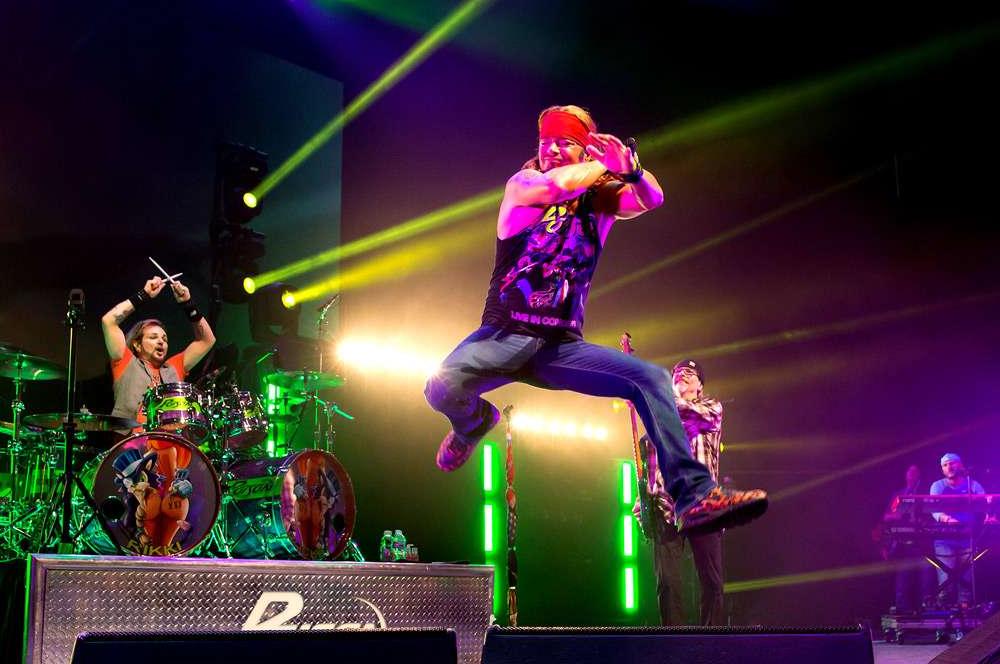
Open up and say . . . Poison. This Eighties glam-metal band is out to have "Nothin' but a Good Time" during its 2018 concert tour.
And rock the band did, following up "Something to Believe In" with . . . "Unskinny Bop"? Leaving aside the spoils of war, this winking rocker seems, thematically at least, cut from the same cloth as AC/DC's "Whole Lotta Rosie," although the band seems mystified by where the term "unskinny bop" came from . . . Never mind, as the band's next move had Michaels, like Cheap Trick's Robin Zander before him, strapping on the acoustic for the chart-topping ballad "Every Rose Has Its Thorn." Again the cameras panned slowly across the misty-eyed roses swaying slowly to memories of their own thorny heartbreaks before the mood shifted abruptly, with Michaels exhorting "California" to have "Nothin' but a Good Time"—this tour's very slogan—as the band closed its set.
Well, there was an awkward interval when it wasn't clear whether the house lights were going to come up or whether the band would return for an encore, but a tattoo from Rockett's drums alerted us to the last hurrah of "Talk Dirty to Me" before Michaels urged us confusingly to "all join the party" and, stranger still, to dig the song coming up on the house PA system, AC/DC's "You Shook Me All Night Long." Then the lights came up, and it was time to leave FivePoint.
Currently, Not in Hall of Fame has Poison ranked at 204 among artists not yet in the Rock and Roll Hall of Fame. Although I have given up on the Rock and Roll Hall of Fame for reasons that I elaborated at length last year, I do have to wonder: Is Poison the Grand Funk Railroad of Eighties hair-metal? Critically reviled, but hugely popular and commercially successful, with a fanbase that is still fairly rabid? Well, perhaps not all are so rabid now—many of the near-capacity crowd had begun filing out about two thirds through Poison's ninety-minute set—but that could just be the Southern California phenomenon of bailing early on any event. (Fittingly enough, Poison released a version of Grand Funk's "We're an American Band" in 2006.)
Poison is thoroughly mediocre. The band does not rise above average. Its songs have no depth beyond their titles, which need no interpretation to uncover the shallow sentiment contained within. But that is what many people seem to need—simple reinforcement of common feelings and beliefs. Or, heavy metal's version of Chicken Soup for the Soul.
Metal of any kind is underrepresented in the Rock and Roll Hall of Fame. But among hair-metal bands, Mötley Crüe (ranked at 70 on this site) and even Ratt (criminally underrated on this site with a ranking at 500—haven't you heard "Lovin' You's a Dirty Job" or "I Want a Woman"?) are much better choices than Poison.
But what do I know? I nixed the idea of Cheap Trick getting into the Rock Hall in 2016. They got elected that year. And for years I kept writing that Deep Purple was not Hall-worthy. Voters finally thought otherwise. After seeing Cheap Trick, even long past its heyday, I don't have a problem with the band making the Rock Hall. Then again, I've abandoned the idea of the "small Hall" that used to drive my evaluations—that is simply futile given the continually evolving, always expansive, and ever inclusive nature of the music. Now the problem is throughput—how to get as many acts into the Hall as quickly as possible. Which then leads to the question of whether the Rock and Roll Hall of Fame has any meaning other than as an ever-growing, scattershot repository of Western rock and pop legacy, but that's for another time.
Still, come September, I'll have a chance to reflect on this anew when I go to see Deep Purple at FivePoint along with Judas Priest (ranked at 10 on this site, and nominated for the first time in 2018). Watch this space for an update—in the meantime, you can find out what I thought of Deep Purple the last time I saw the band.
But in any case, I expect that for a $20 ticket, the price will have been worth it. And that's nothing but a good time.


Comments powered by CComment